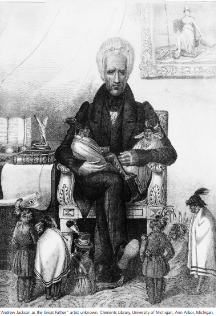
A political cartoon of President Jackson. Source: Course Hero
The growing number of white settlers demanded that native lands be opened for further settlement. Seeing a platform in which he could focus his 1826 Presidential campaign, Andrew Jackson ran on a promise to solve the “Indian problem.” Americans had already seen him as a military hero with victories at the Battle of Horseshoe Bend, and the 1815 Battle of New Orleans, he became the front runner in the eyes of those who were in favor of Indian removal. He was also seen as a “common man” who’s pro-American views would help America to prosper.
“Jackson's attitude toward Native Americans was paternalistic and patronizing -- he described them as children in need of guidance. and believed the removal policy was beneficial to the Indians” (PBS)

A political cartoon of President Jackson. Source: Course Hero
Andrew Jackson as the Great Father', sits in an armchair, holding two diminutive Native Americans on his lap, with others nearby at his feet. The 1835 cartoon satirizes Jackson's belief that the Indian Removal Act of 1830, was merciful and generous. In contrast, on the upper right is a framed picture of Columbia, with her foot on the head of a fallen foe.
Jackson truly thought that there was no way that Native Americans and white settlers could coexist peacefully. His solution was to push for all Native Americans east of the Mississippi River to be removed and sent west of the river.
“From 1814 to 1824, Jackson was instrumental in negotiating nine out of eleven treaties which divested the southern tribes of their eastern lands in exchange for lands in the west." (PBS)